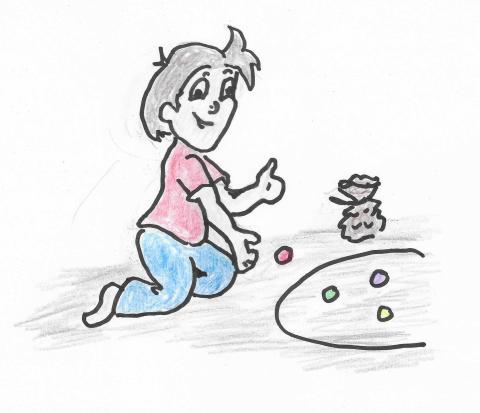Depression: Childhood Games
During the Great Depression, kids had few resources outside of their imagination and old-timey games from a long ago era. My two brothers and myself had no outside resources until I began school. Then the world opened up. We played games in the school yard during recess time and inside when it rained.
“Rock, Paper, Scissors” comes to mind. It takes two to play. Each made a fist and on the count of three made their selection. “Rock” maintained a fist. “Scissors” was extended two fingers like the blades of scissors. “Paper” was extending all the fingers flat. Rock cut scissors. Paper covered rock and scissors cut paper. We played it on the school bus on the ride home.
Kick the can was fun. You needed two old tin cans. Smash it with your feet in the center and try to walk on them. Hard on shoes. There were many rhymes that went with jump rope. I don’t remember any of them.
We played “Duck, Duck, Goose” in the school yard. Everyone formed a circle. One person was “it.” The It person ran around the outside of the ring while everyone shouted “Duck, Duck, Goose!” When the shouting stopped, the “it” person tried to enter the circle. Not easy to do.
Of course, we all know “Hide and Seek.” That is best played in the dark. It was amazing how difficult it was to find someone. Then that person was “it.”
“Freeze Tag” was a similar game. When a person was tagged, he or she had to maintain that exact pose they were in when tagged. The tagging continued until all were found.
“Simon Says” was another good one. It was usually played indoors. The “Leader” would say, “Simon says (something). Everyone would repeat the word or phrase. If the leader did not say “Simon says” before the phrase, the group was not to repeat it. The one who did, then became the leader and so on.
“Follow the Leader” could be harder to do. The Leader formed different poses as he or she walked or ran. Everyone was to do the exact same thing.
For instance, one hand on top of head or hopping on right foot and then left one. “Red light! Green light!” is another tag game. The Leader shouts out either “Red Light or Green light”. Everyone stops or goes on the Leader’s command. Whoever makes the wrong move is the next leader.
“Hot and Cold!” is an indoor game. The leader hides a toy in plain sight somewhere in the room. As the group searches for it, the Leader shouts “Hot!” or “Cold!” as they roam around the room looking for it.
Telephone needs a group. It was best played in school on a rainy day. A group sat in a circle. The first child whispers a short story to the child next to him. He in turn repeated it to the next child and so on around the circle. The fun part was hearing what form the story takes with the last person in the circle. It wouldn’t be the story they started out with. The leader would have several stories to choose from.
“Twenty Questions” is another one for a group. The leader chose a subject. The group had to discover what it was by asking questions. Twenty was the limit. “Is it bigger than a bread basket?” This is similar to Twenty Questions. All the answers refer to its size. Then the item must be guessed.
You need a pool or lake for the next game, “Marco Polo.” If the leader says just says “Marco,” you remain marching in the water. It is not until he says “Marco Polo” that you duck under the water.
There are several paper and pencil games for a rainy or snowy day. “Tic, Tac, Toe” starts with a diagram. Each of two persons in turn places an “X” or a “O” in a square. The first one to fill a strait or diagonal line is the winner. It often depends on who goes first.
“Hangman” is another word game. One person thinks of a word. If the other person, gives a correct letter in the word, the other person does nothing, but a wrong letter gains a part of the hanged man’s body, such as head, arm or leg. To win, the word must be guessed before body is completed.
A pattern of dots is drawn on a paper. One of two persons places a line between two dots anywhere on the pattern. It continues with each one in turn adding lines forming squares. The one who closes the most squares is the winner.
There are many more games. This is just a sample. Many of these games have been played for centuries, such a “Ring Around a Rosy.” It dates back to the Great Plagues of Europe in past centuries.
- Log in to post comments
